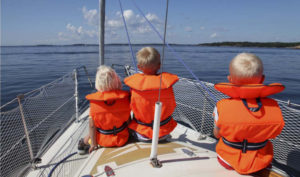
The Port of Coupeville welcomes the return of summer and boaters from around the Puget Sound. While boating is fun, it’s even better when all safety precautions have been considered before launching your craft. Here are some important tips for keeping safety gear aboard and accessible for use while on the water. Practice these, and you’ll hit the open water with confidence.
Life jackets – These should be in good condition and properly sized for every person onboard. Approved inflatable PFD’s count, but only if you’re actually wearing them at all times. And if you’ll be going offshore or navigating through rough waters, consider upgrading them to the Type III variety.
Throw Rings & Cushions – A throw-able PFD (Type IV) is also a must-have. Keep this item on-deck and easily accessible, so if someone falls overboard, you can quickly toss it to them. If your Type IV is more than a few years old, grab the straps or ropes and give them a good tug. If you can rip or break them, the PFD needs to be replaced.
Sound Signal –On many boats, this will be a built-in horn. In other cases, you’ll need to carry a whistle, or an air horn. Yelling doesn’t count!
Fire Extinguisher –One or more fire extinguishers may or may not be required aboard your boat, depending on how it falls into the USCG regulations. Be sure to consult their standards and consider adding extra units in high-risk areas such as the galley and engine room.
Flares –Visual signals may or may not be required by law depending on where you take your boat, but again, the majority of experienced boaters consider these as a necessity onboard. And don’t forget, they have a limited life-span. Check at the beginning of every season, to make sure yours are current and operational.
Navigation Lights – This is another item that is required for some boats, but not all of them. Usually, if they’re required the boat will have them built in already. If not, you can take portable lights with you and mount them on the boat when needed. In any case, test your lights before any trip when you think there’s a possibility you’ll be on the water at or after dark.
First Aid Kit – This is an absolute necessity aboard any boat. When you’re out on the water you may not be able to get to help for several minutes or even hours, so make sure you have plenty of first aid basics safely stowed onboard.
Extra Food & Water –Even inland and near-shore boaters should always have an emergency supply of food and water, even if it’s just a granola bar and a plastic bottle. You never know when mechanical difficulties could leave you stranded or force a long hike back to the boat ramp.
Safety Briefing –Whenever you take out guests, be sure to start the trip with a safety talk. Show them where all the gear is stowed, and how to use it. Otherwise, valuable time may be lost during an emergency.
Kill Switch –If your boat came with a safety lanyard and kill switch, make sure you use them. If you’re thrown from the helm and the engines keep running, the rest of the safety gear won’t help you one bit—as you watch it cruise away with no one at the wheel.
Washington Boating Education Requirements
All operators born on or after January 1, 1955 must have a Washington Boater Education Card to operate a vessel powered by a motor of 15 or more horsepower. Find out more and check out the online boating safety course at www.boat-ed.com.
